The modern has made it impossible to escape the term job abandonment. The concept has become extremely relevant with each passing day, especially in the current economic landscape around the globe. The phenomenon is a perplexing problem that has been creating challenges for both employers and employees.
Let’s try to ease the trouble job abandonment is creating and understand together what it is, its definition, what can be described as job abandonment, its consequences, the reasons behind it, and more! Let’s dive right in.
Table of Contents
What Is Job Abandonment?
Job abandonment is a popular phenomenon that describes a situation where an employee simply stops coming to work or stops performing their duties. The term abandonment is used because this happens in a sudden manner without any previous warning.
Essentially, it’s an unannounced and unexplained disappearance that can manifest in different ways. At times it might be just an employee missing work shifts or ignoring the employer’s attempts at communication. Other times it can be neglecting responsibilities again without any form of communication.
Regardless of the underlying reasons for job abandonment, it’s an event that can cause serious challenges for both the employer and the employee. On the employer’s end, job abandonment disrupts the workflow with serious uncertainty of when the order will be back to normal.
On the employee’s end, it’s very likely to result in the termination of work and damaging their professional reputation in the process, not to mention potential legal action that may follow. Either way, job abandonment is a serious issue that should not be taken lightly and organizations need to be prepared to avoid it.
Examples of Job Abandonment
To paint a clearer picture, here are some examples of what job abandonment can look like.
- No-Show With No Communication: An employee who has abandoned their job may not show up to the office for several consecutive days. During this time they are likely unavailable to the employer’s attempts at reaching out to try and find out what exactly is happening. The employee basically disappears without a trace behind.
- Unannounced Extended Absence: Another example could be a similar scenario. Perhaps this employee has felt there is no longer room to grow in the current position and has had enough. Similar to the first examples they may for this reason not come in and yet not call in sick or notify the employer of their intentions to leave.
- Not Coming Back From Leave: There may also be employees who take leave before they disappear. Let’s say an employee has had vacation days but by the time the vacation period is over, they’re still not reachable and don’t show up to their job.
- Ignoring Duties: A normally very diligent and thorough employee may one day stop carrying out their responsibilities simply because they are too overwhelmed and don’t want to be anymore. They may stop responding to emails, miss deadlines, and miss important meetings too, not doing even the most simplistic tasks, which is another form job abandonment might take.
In each perspective, the commonality is that the set of duties determined by the employer are not being carried out out of the blue. There is no communication why the job abandonment is happening and may never be an explanation at any point down the road either. As you can imagine the sudden and uncertain nature of the situation can be very damaging to an organization.
Why Does Job Abandonment Occur?
There are six main reasons why job abandonment may be happening. Let’s take a closer look.
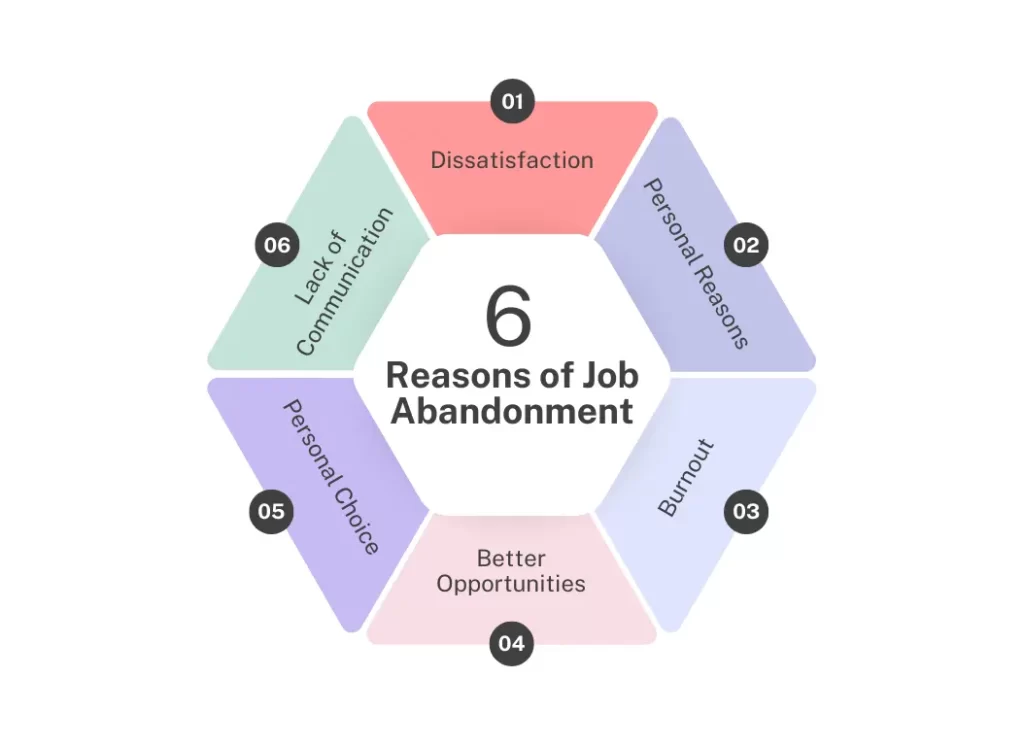
- Dissatisfaction In The Workplace: One of the main reasons behind job abandonment is dissatisfaction. Employees who are not happy with their current status are much more likely to abandon their roles compared to others who aren’t. If for example, employees feel their no more room for advancement, the working conditions are poor, the culture is toxic within the organization, or unsatisfactory compensation, the job stops being valuable to the employee but becomes a burden. Persistent dissatisfaction will inevitably lead to employee disengagement.
- Personal Issues: The workforce may also be affected by their personal circumstances. Certain personal challenges or crises can make it hard to come to work and perform daily tasks. These issues can vary from health problems to family emergencies, but regardless of the reason if employees are not supported within the organization in terms of employee wellbeing with tools like pulse surveys and feedback, the result could be abandoning the job altogether.
- Burnout: Prolonged periods of stress, excessive workload, and lack of work-life balance can lead to burnout, which is a state of physical, emotional, and mental exhaustion. Burnout can be the ultimate reason why employees choose to leave without notice, due to the immense loss of motivation, become disengaged, and ultimately abandon their jobs.
- Better Opportunities: Other times, the reason could come down to a more simplistic root. The abrupt leave can be because the employee has found a new role elsewhere. Whether it’s a higher salary, better benefits, or a more fulfilling role, the prospect of a new job can encourage employees to abandon their current position without explanation. The only way to combat this is to find several ways to stay competitive in your industry and have strategies to increase retention in place.
- Personal Choice: In other situations, the abandonment may be because of personal choices that will likely only make sense to the employees themselves. They may simply no longer wish to continue for various reasons such as wanting to retire, wanting a career change, or personal issues completely unrelated to work.
- Lack of Communication: While good communication resolves a lot, on the other end of that coin, poor communication brings about so much trouble in every sense. If employees are feeling undervalued, not listened to, or unable to receive support, they are highly likely to remove themselves from the situation at the first opportunity they get. Poor communication between employees and employers can also contribute to job abandonment. Since communication is already not well, they may choose to do so unannounced and unexplained.
The Consequences of Job Abandonment
We’ve gone over a lot of information on job abandonment but not what it results in. Yet! Let’s see the consequences of job abandonment.
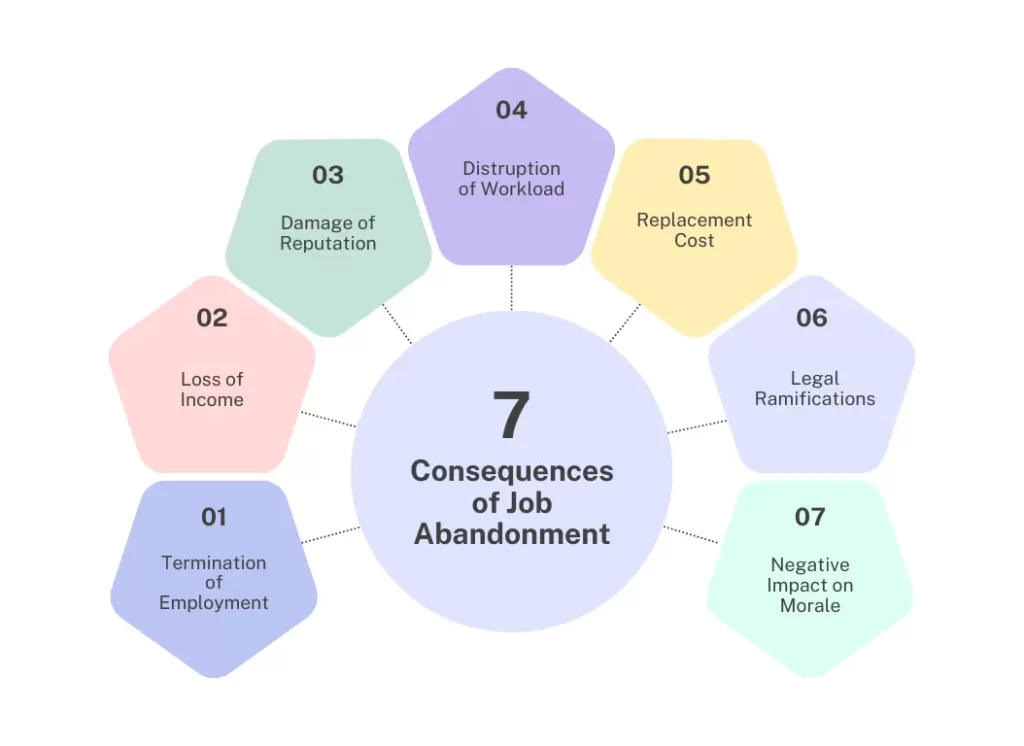
- Termination of Employment: In many cases, job abandonment will lead to the termination of employment. When an employee fails to report to their job for an extended period without explanation or authorization, it will likely be considered a breach of contract.
- Loss of Income: For employees who abandon their jobs without a new opportunity already found, the most immediate result of job abandonment is the loss of income. Without a job, they may struggle to meet their financial obligations and support themselves and their families, which arguably is the hardest consequence of them all.
- Damage to Professional Reputation: When an employee abandons their position, they also risk damaging their credibility and reputation as a professional. This can make it harder for them to secure a position elsewhere and employers may be reluctant to entrust other duties to them.
- Disruption to Workforce and Operations: From an employer’s perspective, job abandonment is highly likely to disrupt workforce planning and operations in an organization. If an employee unexpectedly leaves without notice, it may create gaps in workflow, take a toll on team dynamics, and increase the workload for the remaining workforce.
- Cost of Replacement: From the organization’s point of view, the loss of an employee means having to replace them. This is inevitably going to cost the organization in terms of hiring and training efforts. Recruiting expenses, onboarding costs, and productivity losses during the transition period can all contribute to the financial impact of job abandonment in an organization.
- Legal Ramifications: An employee abandoning their job may have legal consequences depending on the terms of their contract or the labor laws in the area. Employers may have to follow certain protocols during termination which can cause legal ramifications on the employee.
- Negative Impact on Morale: While the most direct consequences of job abandonment are to the employer and the employee, it can also affect the remainder of the workforce dramatically. Not only in the sense that the distribution of the workload will be on fewer people but also because the speculated reasons behind the disappearance will affect motivation within the rest of the team. Employees may feel demoralized by the sudden departure and uncertain about the stability of their own positions.
Job Abandonment Throughout Industries
Job abandonment is a phenomenon that’s not entirely limited to industry. It’s an event that can dramatically affect any business of any size. From retail and hospitality to healthcare and technology, no sector is immune to the impact and challenges job abandonment may raise.
In sectors such as retail and hospitality, for example, high turnover rates and demanding workplaces may encourage employees to seek employment elsewhere. In healthcare, in a similar manner, where staff shortages are a common occurrence, workloads tend to be overwhelming, hence the high turnover rates.
In the technology sector, competition for talent is extremely fierce which can lead to employees being snatched away by competitors who offer bigger and better benefits. On such occasions, job abandonment is a real struggle, especially for organizations that are competing to retain top talent in order to have a competitive edge within their industry.
Even in traditionally stable industries like finance and manufacturing, job abandonment is a possibility through factors like corporate restructuring, layoffs, or leadership changes. Across all sectors, the only way to address and prevent job abandonment is to find and treat the root causes of it. Keeping open communication channels during those efforts will be a great tool in doing so.
How To Prevent Job Abandonment?
To prevent job abandonment, you will have to implement a proactive approach that will help mitigate its consequences. Looking for ways to create a pleasant and positive work environment that encourages harmony, collaboration, and value is your best bet.
At the end of the day, only when you create mutual trust and respect will you be able to avoid job abandonment and promote long-term retention in your organization. So let’s take a look at a couple of proactive ways you can achieve that in your day-to-day!
Promote Team Building
Promoting team building is integral to creating a cohesive environment in the workplace where your employees will feel valued and have a sense of belonging to their organization. This is of utmost importance if you wish to combat job abandonment.
One great way to promote team building is to use the right software. Teamflect is an all-in-one performance management solution that can provide you with all of your management needs under one roof. Better yet, it’s inside Microsoft Teams!
With Teamflect’s help, you can promote a workplace that thrives on a dynamic and harmonious culture. From remote team management and employee onboarding to project management, Teamflect will be the tool that helps you cultivate a collaborative space at every step.
Regular Employee Engagement / Satisfaction Surveys
Keeping engagement high will be another part of preventing job abandonment in your team. If you create an engaging culture, it will contribute positively to their feelings and motivation towards their role and encourage them to put out their best work.
Using surveys to ensure that your efforts in cultivating a positive culture at work are a great way to keep informed on the latest news from your workforce. This way, with their insights, you’ll be able to create an action plan better curated to your employees’ wants and needs.
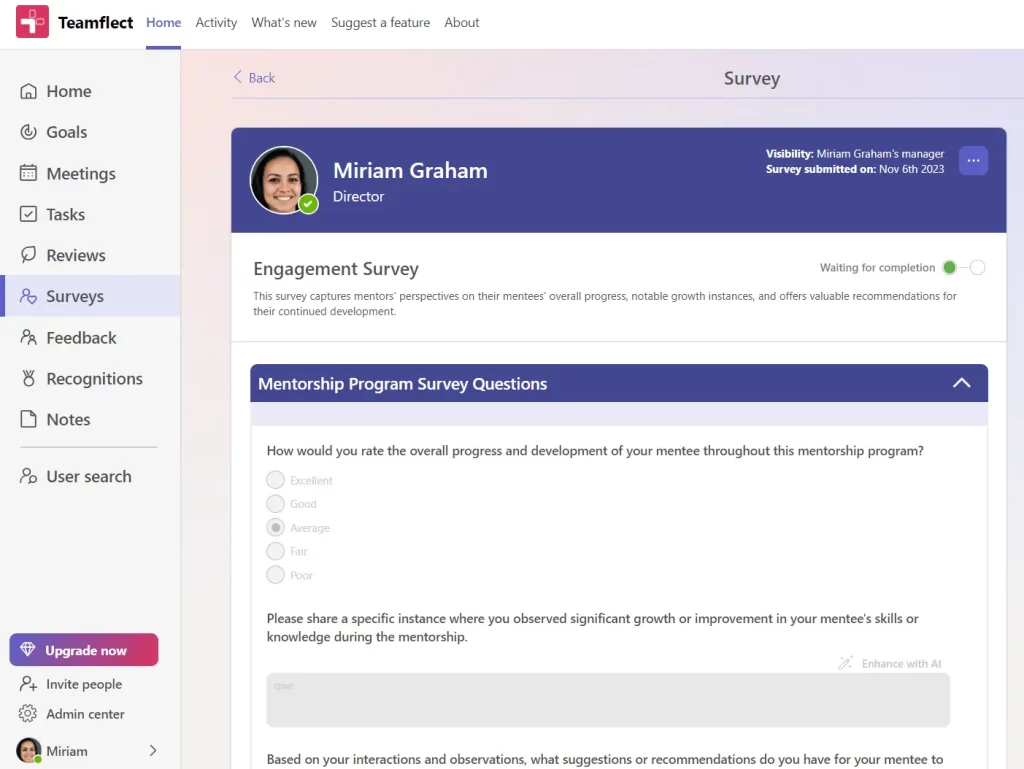
Simply click on Teamflect’s survey module and click on “new survey”. From there you can customize our templates to create the kind of survey you require, curated towards your needs.
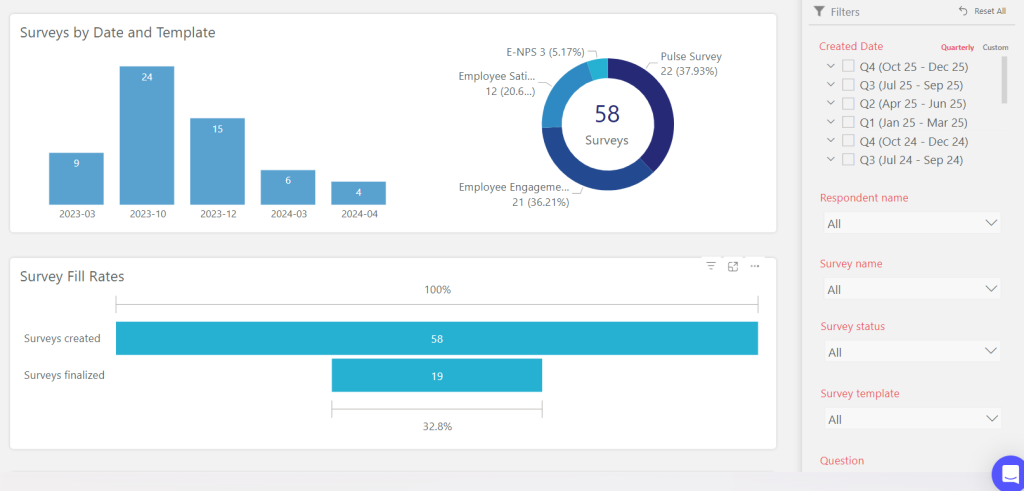
Once you’ve collected some data, it’s up to Teamflect to gather and provide the right analysis to guide you in your efforts. You can even summarize the data we provide with the built-in AI feature and cater to your specific needs even more!
Regular Check-ins
Having regular check-ins with your employees will make sure that you have the best insights from your team about their experiences within the organization. This way, you can actually address any issues or work on bettering your organizational processes, which will help avoid job abandonment.
It’s easy to arrange this through Teamflect’s meetings module!
With the meeting feature, you can;
- Track goals / OKRs inside 1:1 meetings to ensure goal alignment.
- Set and manage tasks inside ongoing Teams meetings.
- Create comprehensive meeting agendas with recurring talking points.
- Take shared and private meeting notes to capture all the important details.
Through the meetings module, you can make sure that your team is staying in touch consistently and are aligned on every level when it comes to their professional relationship with the organization.
Implement Rewards & Recognition
Making sure to reward your people for their hard work is a fundamental element of avoiding job abandonment. If your employees do not feel valued or celebrated for their efforts, they will be that much more likely to find a space that does.
Luckily Teamflect has a great rewards and recognition feature that has just the thing for you!
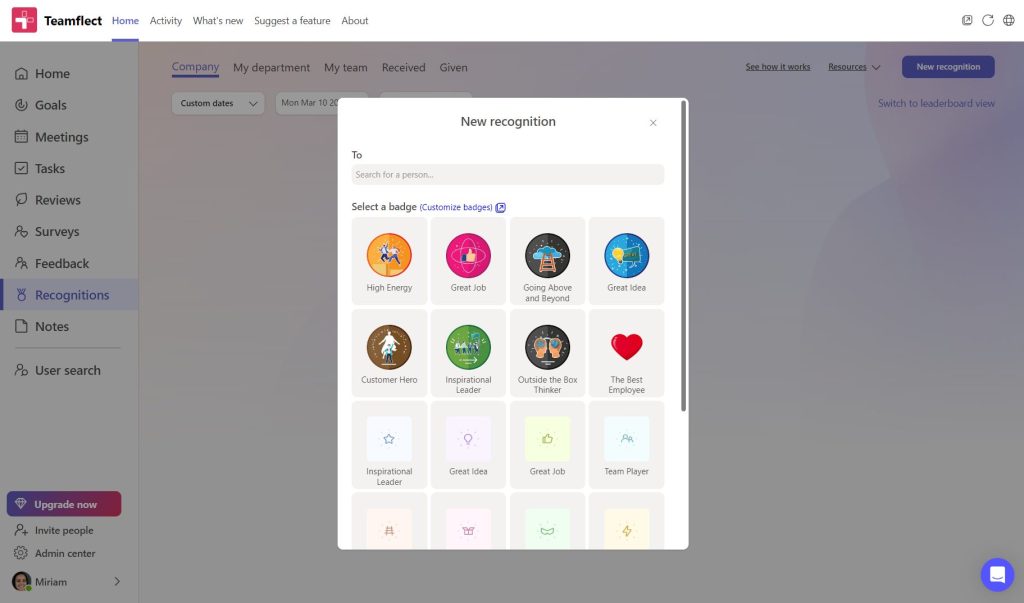
By going into the recognition module inside Teamflect, and clicking on the “new recognition” button in the top right corner, you can start creating your own customized recognitions for your team.
Teamflect offers you;
- Customizable recognition badges to reflect your company values
- Create manager/admin-only recognition badges to recognize high-performers
- Send private recognitions to celebrate success in confidential projects
- Implementation of recognition and reward into other features such as meetings and goals.
With Teamflect, you never have to miss an opportunity to celebrate your workforce. Try Teamflect today to see how easily it is implemented into your daily life as a professional and avoid job abandonment!



